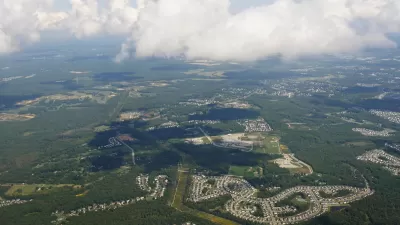The successes of Arlington, Virginia as a suburb have been discussed by planners and urbanists before, but the model has taken on new meaning as the current urban boom send ripple effect out into nearby suburbs like Long Island and Palo Alto.

An article by Henry Grabar details the success of Arlington, Virginia in implementing the benefits of urban life, while also limiting some of its negative impacts: "Despite the influx of tens of thousands of workers and residents, despite the transformation of this sleepy suburb into a mid-size city, traffic has thinned."
"In essence, Arlington has shown that the mistakes of American suburban development can be corrected within a few decades." And how'd it do that? "[Without] citizens’ willingness to support high-density zones, Arlington would still look much as it did in the Kennedy administration."
Here's how Grabar describes some of the planning choices that lead to Arlington's success. "Around the new Metro stops, the county devised a series of “bull’s-eye” plans for high-density, mixed-use developments. Between 1970 and 2000, the Rosslyn-Ballston corridor— just two square miles — added 15 million square feet of office space and 15,000 residential units. Adding in the Metro corridor in nearby Crystal City, Arlington’s seven “station sectors” produce half of the county’s real estate revenue from just 7 percent of its area. It may be the only American suburban district where fewer than half of residents drive to work."
Among the background reportage driving Grabar's Salon story comes from an article by Canaan Merchant for Greater Greater Washington, which details the statistics behind Arlington's reduction of vehicle traffic and its increased use of transit (compared to Grabar, who builds the narrative of how Arlington got to its unique position). Summing up how Arlington achieved the results detailed in the post, however, Merchant says, "Arlington has embraced transit-oriented development and walkability for a long time, but in the 1970s and '80s when the county was originally debating its plans, some of Arlington's choices seemed like risky moves."
Grabar's larger, political point, is pointed toward the NIMBY culture of the suburbs surrounding cities like San Francisco and New York City: "But without a doubt, there’s one lesson whose import will resonate with suburbanites from Huntington to Palo Alto: No suburb can urbanize without the support of its residents."
FULL STORY: The suburb of the future is here

Manufactured Crisis: Losing the Nation’s Largest Source of Unsubsidized Affordable Housing
Manufactured housing communities have long been an affordable housing option for millions of people living in the U.S., but that affordability is disappearing rapidly. How did we get here?

Americans May Be Stuck — But Why?
Americans are moving a lot less than they once did, and that is a problem. While Yoni Applebaum, in his highly-publicized article Stuck, gets the reasons badly wrong, it's still important to ask: why are we moving so much less than before?

Using Old Oil and Gas Wells for Green Energy Storage
Penn State researchers have found that repurposing abandoned oil and gas wells for geothermal-assisted compressed-air energy storage can boost efficiency, reduce environmental risks, and support clean energy and job transitions.

Greening Oakland’s School Grounds
With help from community partners like the Trust for Public Land, Oakland Unified School District is turning barren, asphalt-covered schoolyards into vibrant, green spaces that support outdoor learning, play, and student well-being.

California Governor Suspends CEQA Reviews for Utilities in Fire Areas
Utility restoration efforts in areas affected by the January wildfires in Los Angeles will be exempt from environmental regulations to speed up the rebuilding of essential infrastructure.

Native American Communities Prepare to Lead on Environmental Stewardship
In the face of federal threats to public lands and conservation efforts, indigenous groups continue to model nature-centered conservation efforts.
Urban Design for Planners 1: Software Tools
This six-course series explores essential urban design concepts using open source software and equips planners with the tools they need to participate fully in the urban design process.
Planning for Universal Design
Learn the tools for implementing Universal Design in planning regulations.
Heyer Gruel & Associates PA
City of Moreno Valley
Institute for Housing and Urban Development Studies (IHS)
City of Grandview
Harvard GSD Executive Education
Salt Lake City
NYU Wagner Graduate School of Public Service
City of Cambridge, Maryland





























